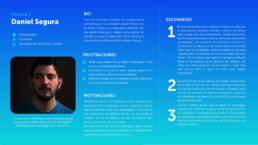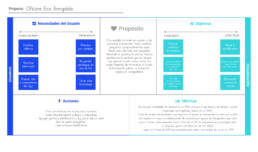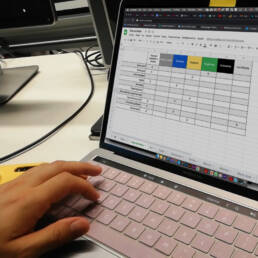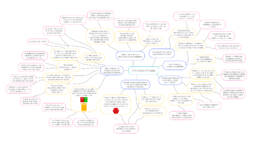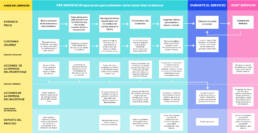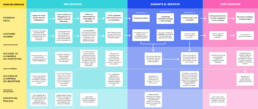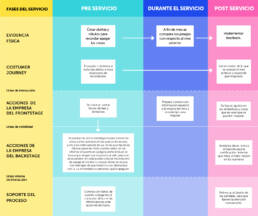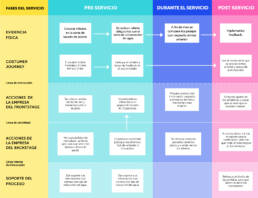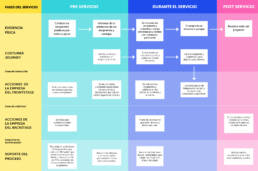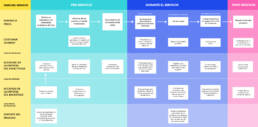Overview
I was working on this before the pandemic for my workplace’s office to help the PBAE team (the people in charge of making the office win a national eco badge). The goal was to analyze the work this team was doing to bring solutions to make everything more efficient and change what wasn’t working. Hopefully, I hope this can be applied when we return to the office.
- Client: Wunderman Thompson SJO, PBAE (Proyecto Bandera Azul Ecológica) committee.
- Scope: All the employees from Wunderman Thompson who are based in Costa Rica.
- Project Date: From January 2020 to April 2020.
- Role: UX researcher and service designer.
Problem statement
I wanted to help my coworkers and myself to change our mentality towards the environment. The reasoning behind this is that I know it’s imperative to change our behaviors if we’re going to have a chance of a better future for ourselves and future generations.
This problem is particularly challenging since many Millennials and Gen X still don’t care about these topics. When they care, they don’t know how to change small things to make significant differences. These changes could translate to the office winning an environmental certification (the organization needs to have at least one for global reviews). Also, it can help the office by reducing waste, electric bills, and office supplies drastically.
Solution
I conducted a research-based work using the scientific method, mixed with interviews, tests with the users, and tools like affinity diagrams and service blueprints. The blueprints helped me to map the best ways to handle the MVPs, so it was easier to understand how to proceed in each eco-solution.
Roles and responsibilities
I worked on this college project solo, just guided by my professor back then, Keren Ramírez. I wanted to work on this because it’s imperative to reduce the carbon footprint previous generations left, so we can all have a better place to live. Also, I’m very into service design; that’s why I put myself the challenge to work on this kind of project.
Scope and constrains
- The population sample I studied: Wunderman Thompson employees. Ages between 25 and 40 years old.
- The project's duration: took about four months to make the whole research, interviews, and design proposal.
- The topics or theories that you will discuss: "Is it possible to change behaviors in adults?" and "What are the best ways to educate adults?"
- The geographical location covered in the study: Wunderman Thompson's office in San José, Costa Rica.
Research insights
The project began with research based on the scientific method around the pillars of the topic of fixing an office that isn’t very eco friendly: 3 R’s in the environment (reducing waste, reusing and recycling resources and products), waste disposal, and how to educate adults on these topics. So based on that, the most important insights were:
- Most employees (around 98%) don’t know how to separate the most common correctly.
- It’s imperative to improve the recycle bins signage so that people can reduce the mistakes.
- Most employees haven’t used or know of the existence of the food containers to buy in the food court without using 1-time use plastic containers.
- People want to learn more about environmental matters, but they need motivation and to start their curiosity.
- If the office wants to win the “Bandera Azul Ecológica” certification, they need to change how they abord these topics.
Deliverables
After the research, the next step I took was the deliverables. The first one was the personas because I wanted to have a clearer picture of my users. After that, I proceed with the scope canvas to set the data I need for more accurate interviews. Having the interviews with the employees with a quick recycling test and the other interview expert in the matter, I continued to the affinity diagram to visualize what I would develop in the service blueprints.
Based on the research, and with the guidance of my professor, we concluded that there are three major groups of personas. The sections for each persona profile were: bio, interests, a quote to describe a little more that type of user, pain points, motivations, and scenarios.
The first and biggest one is employees who want to recycle and cooperate with the cause but don’t know the matter. The second one is the small group of employees who have more experience with environmental topics. And last one, the other small group of employees who think that going green is an exaggerated problem and polluting won’t hurt much.
(All the deliverables were created in Spanish, as soon as possible, I’ll translate them).
The scope canvas came after the personas, giving a more concrete and objective focus to the project based on the research. Here I set the user’s needs, purpose, goals, actions, and metrics.
(All the deliverables were created in Spanish, as soon as possible, I’ll translate them).
Interviews goal
20.
Total of interviews made
18.
Population of interest
Wunderman Thompson’s employees, with an average age between 25 and 40 years.
Type of interview
Structured.
Sampling frame
Employees from every single department of the office.
Total of questions
Fourteen and a quick test.
The short test I made for a sample of 18 employees had the goal to see if they knew how to separate waste when you recycle. In the end, just one person had all the answers correct. So with these results, I concluded that workers, in general, didn’t know how to recycle correctly and needed help with this.
- Total number of tests performed: 20.
- Total performed: 18.
- Population of interest: Wunderman Thompson employees, with an average age between 25 and 40 years old.
- Type of sampling: examination.
- Percentage of people with 100% correct answers: 0.
- Sampling frame: employees from all departments in the office.
To confirm if it was possible to train and educate adults in ecological matters, I made an interview with an expert in the matter, Jatzel Hidalgo Jiménez. The biggets insights here were:
- It is possible to educate adults. It is important, in these cases, to treat them like kids in a matter of education. Adults also like interactive and ludic learning.
- The company should consider taking the employees to an educational eco-tour so that they can learn easier.
- People tend to pay more attention to outsiders than their peers.
This deliverable had the purpose of setting the leading active solutions for the problem resolution. This deliverable was divided into six categories that the office needed to go green and win the PBAE certification:
- Reduce emissions the employees generate when they move to the office.
- Reduce water consumption when employees clean their dishes.
- Raise awareness for the use of reusable containers and cutlery.
- Motive the employees to join and participate in pro-environment activities.
- Have a method of helping the employees to remember to turn off the lights and electronic devices.
- Help employees to learn how to classify their waste.
(All the deliverables were created in Spanish, as soon as possible, I’ll translate them).
The blueprints were the last ones. I based them on the affinity diagram; I made six service blueprints for developing further the solutions. The office’s goal back then was to recover the PBAE certification finally, so these deliverables were focusing on that, and by consequence, it will also be greener.
The six cases were:
- Learn to prepare the waste before classifying it to be disposed of.
- Reduce the carbon footprint the employees produce when they go to the office.
- Turn off the lights and electronic devices.
- Reduce water consumption when employees clean their dishes.
- Have a method of helping the employees to remember to turn off the lights and electronic devices.
- Raise awareness for the use of reusable containers and cutlery.
(All the deliverables were created in Spanish, as soon as possible, I’ll translate them).
Based on the research, and with the guidance of my professor, we concluded that there are three major groups of personas. The sections for each persona profile were: bio, interests, a quote to describe a little more that type of user, pain points, motivations, and scenarios.
The first and biggest one is employees who want to recycle and cooperate with the cause but don’t know the matter. The second one is the small group of employees who have more experience with environmental topics. And last one, the other small group of employees who think that going green is an exaggerated problem and polluting won’t hurt much.
(All the deliverables were created in Spanish, as soon as possible, I’ll translate them).
The scope canvas came after the personas, giving a more concrete and objective focus to the project based on the research. Here I set the user’s needs, purpose, goals, actions, and metrics.
(All the deliverables were created in Spanish, as soon as possible, I’ll translate them).
Interviews goal
20.
Total of interviews made
18.
Population of interest
Wunderman Thompson’s employees, with an average age between 25 and 40 years.
Type of interview
Structured.
Sampling frame
Employees from every single department of the office.
Total of questions
Fourteen and a quick test.
The short test I made for a sample of 18 employees had the goal to see if they knew how to separate waste when you recycle. In the end, just one person had all the answers correct. So with these results, I concluded that workers, in general, didn’t know how to recycle correctly and needed help with this.
- Total number of tests performed: 20.
- Total performed: 18.
- Population of interest: Wunderman Thompson employees, with an average age between 25 and 40 years old.
- Type of sampling: examination.
- Percentage of people with 100% correct answers: 0.
- Sampling frame: employees from all departments in the office.
To confirm if it was possible to train and educate adults in ecological matters, I made an interview with an expert in the matter, Jatzel Hidalgo Jiménez. The biggets insights here were:
- It is possible to educate adults. It is important, in these cases, to treat them like kids in a matter of education. Adults also like interactive and ludic learning.
- The company should consider taking the employees to an educational eco-tour so that they can learn easier.
- People tend to pay more attention to outsiders than their peers.
This deliverable had the purpose of setting the leading active solutions for the problem resolution. This deliverable was divided into six categories that the office needed to go green and win the PBAE certification:
- Reduce emissions the employees generate when they move to the office.
- Reduce water consumption when employees clean their dishes.
- Raise awareness for the use of reusable containers and cutlery.
- Motive the employees to join and participate in pro-environment activities.
- Have a method of helping the employees to remember to turn off the lights and electronic devices.
- Help employees to learn how to classify their waste.
(All the deliverables were created in Spanish, as soon as possible, I’ll translate them).
The blueprints were the last ones. I based them on the affinity diagram; I made six service blueprints for developing further the solutions. The office’s goal back then was to recover the PBAE certification finally, so these deliverables were focusing on that, and by consequence, it will also be greener.
The six cases were:
- Learn to prepare the waste before classifying it to be disposed of.
- Reduce the carbon footprint the employees produce when they go to the office.
- Turn off the lights and electronic devices.
- Reduce water consumption when employees clean their dishes.
- Have a method of helping the employees to remember to turn off the lights and electronic devices.
- Raise awareness for the use of reusable containers and cutlery.
(All the deliverables were created in Spanish, as soon as possible, I’ll translate them).
Final results
The following results show the data extracted and analyzed from the interviews with employees and the recommendations given by the environmental expert in workplaces. The items were classified by deadlines that are feasible to meet. Ultimately, the extra data will serve for the improvement of the project outside a timeline. Those insights are essential to improve the project.
Feasible changes
Education and rewards
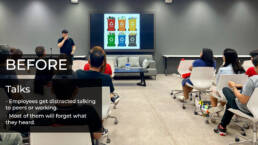
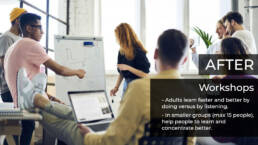
Short term:
- Rethink the content of e-mails and simplify them.
- Use the screens to give messages and tips on ecology.
- Resume the activities of documentaries on the environment with trivia with prizes to motivate employees.
Mid-term:
- Change the modality of talks to the entire office for interactive workshops in groups of no more than 15 people.
Waste disposal
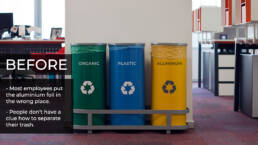
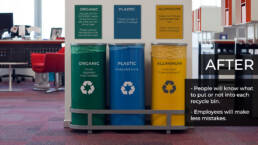
Short term:
- Fix the labeling of the dumpsters with explanations of what goes in each one.
- Change the positions of the dumpsters strategically (put the ordinary dumpster in the most complicated access).
- Give more advance notice of recycling campaigns, at least the week before.
- Move the plastic food containers to a more visible area so that people remember them.
Mid-term:
- Substitute, as far as possible, foods with plastic packaging. For example, put more fruit.
Carbon footprint


Short term:
- Keep WFH as much as possible after the pandemic.
Extra insights based on the interviews with the employees
- Employees do not understand what the "Packaging" category means and what goes into it.
- Many are disgusted to use the plastic containers provided by the office, as they feel they are not hygienic.
- Almost all workers got the aluminum foil classification wrong.
- Many employees do not understand how organic waste works.
- They do not know how to deal with teabag waste (only one person answered correctly what plastics are recycled in CR).
- It is unclear what the PBAE certification is about and whether it has anything to do with the "Amigos del Río Torres" project.
- In general, there is a lack of knowledge of how plastic is disposed of. People do not know what types are recycled and how they are treated.
- Many employees are interested in the subject and care about it, but they do not understand how to do things, so they need better guidance.
- Employees do not understand what the "Packaging" category means and what goes into it.
- Many are disgusted to use the plastic containers provided by the office, as they feel they are not hygienic.
- Almost all workers got the aluminum foil classification wrong.
- Many employees do not understand how organic waste works.
- They do not know how to deal with teabag waste (only one person answered correctly what plastics are recycled in CR).
- It is unclear what the PBAE certification is about and whether it has anything to do with the "Amigos del Río Torres" project.
- In general, there is a lack of knowledge of how plastic is disposed of. People do not know what types are recycled and how they are treated.
- Many employees are interested in the subject and care about it, but they do not understand how to do things, so they need better guidance.
Conclusions
Based on the research data, the question as to whether it is possible to educate adults on environmental issues is considered positive. A series of aspects that prove this fact will be listed below:
- It is essential to look for the correct stimuli to generate motivation in environmental topics.
- Jatzel Hidalgo Jiménez indicated that adults function the same as children in educational matters, so it is necessary to look for striking ways for them.
- The company can achieve educational levels in environmental issues if the data stipulated in this research are analyzed.
Lessons learned
Based on my learning from this project, I recommend following the stipulations of this use case after the pandemic. It will help promote employee education and motivation to raise awareness of environmental issues. Going further, other recommendations based on my experience would be:
- Stop buying food that comes with individual plastic packagings.
- It's essential to improve the labeling of the recycling bins and trash cans.
- Employees’ are aware of the natural consequences of the contamination, but they need guidance in the matter (like showing documentaries).
- Keep the WFH after the pandemic as much as possible to reduce the carbon footprint.
- Change the location of the office’s food containers to a more visible one and consider putting cutlery too.


